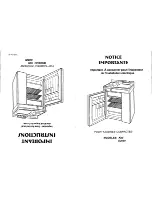
8
TROUBLESHOOTING
GUIDE
PROBLEM
Appliance does not run.
*
Appliance is plugged into a
circuit that has a ground fault
*
Us e another circuit. If you are uns ure about the
outlet, have it checked by a certified technician.
*
Tem perature control is in the
"OFF" pos ition.
*
See Therm os tat Setting.
*
Appliance m ay not be plugged in,
or plug m ay be loos e.
*
Ensure plug is tightly pus hed into outlet.
*
Hous e fus e blown or tripped
circuit breaker.
*
Check/replace fus e with a 15 am p tim e delay
fus e. Res et circuit breaker.
*
Power outage
*
Check hous e lights . Call local Electric Com pany.
Appliance runs too m uch
or too long.
*
Room or outs ide weather is hot.
*
It's norm al for the appliance to work harder under
thes e conditions .
*
Appliance has recently been
dis connected for a period of tim e.
*
It takes 24 hours for the appliance to cool down
com pletely.
*
Large am ount of warm or hot
food have been s tored recently.
*
Warm food will caus e appliance to run m ore until
the des ired tem perature is reached.
*
Door is opened too frequently or
kept open too long.
*
Warm air entering the appliance causes it to run
m ore. Open the door les s often.
*
Appliance door m ay be s lightly
*
See "Door Problem s ".
*
Tem perature control is s et too
low.
*
Turn control knob to a warm er setting. Allow
s everal hours for the tem perature to stabilize.
*
Appliance gas kets are dirty,
worn, cracked or poorly fitted.
*
Clean or change gas ket. Leaks in the lid s eal will
caus e appliance to run longer in order to m aintain
des ired tem perature.
Interior appliance
tem perature is too cold.
*
Tem perature control is s et too
low.
*
Turn control knob to a warm er setting. Allow
s everal hours for the tem perature to stabilize.
Interior appliance
tem perature is too warm .
*
Tem perature control is s et too
warm .
*
Turn control knob to a colder s etting. Allow s everal
hours for the tem perature to s tabilize.
*
Door is opened too frequently or
kept open too long.
*
Warm air entering the appliance causes it to run
m ore. Open the door les s often.
*
Appliance door m ay be s lightly
*
See "Door Problem s ".
*
Large am ount of warm or hot
food have been s tored recently.
*
Wait until the appliance has had a chance to
reach its s elected tem perature.
*
Appliance has recently been
dis connected for a period of tim e.
*
appliance requires 24 hours to cool down
com pletely.
Appliance external
s urface tem perature is
warm .
*
The external appliance walls can
be as m uch as 30ºF warm er than
room tem perature.
*
This is norm al while the com pres s or works to
trans fer heat from ins ide the appliance cabinet.
Louder s ound levels
whenever appliance is
on.
*
Modern appliances have
increas ed s torage capacity and
m ore s table tem peratures . They
require heavy duty com pres sors .
*
This is norm al. When the s urrounding nois e level
is low, you m ight hear the com pres s or running
while it cools the interior.
Louder s ound levels
when com pres s or
com es on.
*
Appliance operates at higher
pres s ures during the start of the
ON cycle.
*
This is norm al. Sound will level off or dis appear
as appliance continues to run.
Popping or cracking
s ound when com pres s or
com es on.
*
Metal parts undergo expans ion
and contraction, as in hot water
pipes .
*
This is norm al. Sound will level off or dis appear
as appliance continues to run.
SOUND AND NOISE
CAUSE
CORRECTION
Before calling for s ervice, review this lis t. It m ay s ave you tim e and expens e. This lis t
includes com m on occurrences that are not the res ult of defective workm ans hip or
m aterials in this appliance.
APPLIANCE OPERATION





























